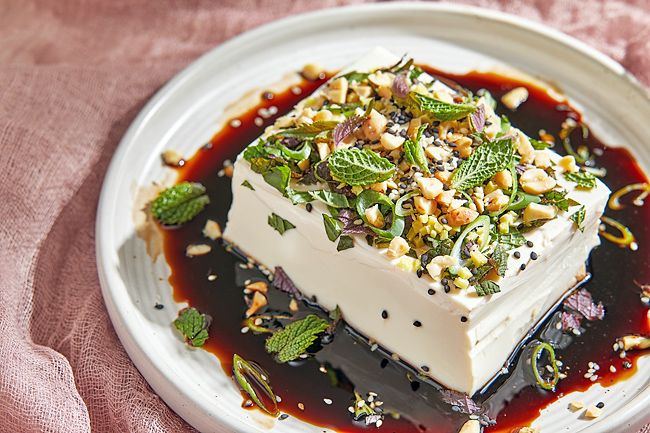Joe Yonan
THE WASHINGTON POST – There’s a glass-half-empty/glass-half-full way of looking at tofu. The former is that it’s too bland to be interesting. The latter is that it’s a versatile backdrop for powerful flavours.
Consider this: Have you ever heard somebody say they find fresh mozzarella too bland and boring for a Caprese salad? On the contrary, it’s celebrated as the soothing counterpoint to acidic tomatoes, grassy olive oil, peppery basil. There are lots of other possibilities, too, including balsamic vinegar and crushed red pepper flakes.
I view this tofu recipe as the Japanese equivalent of the Caprese, with some obvious exceptions: It’s built using a single block of silken tofu, which you may never have eaten in such a way, but trust me, you should. You top it with a riot of herbs, aromatics, scallions, peanuts and high-quality soya sauce, serve it cold, and let your guests spoon their portions out, eating it as an appetiser as is or perhaps with rice as a main course. The tofu is almost puddinglike, and its subtle nutty flavour and smooth, creamy texture play off the crunchy,
salty toppings.
In the summer when I want something that doesn’t require any heat at all, I riff on a recipe from Harumi Kurihara’s 2020 book, Harumi’s Japanese Kitchen. I start with store-bought silken tofu – I like to use the shelf-stable kind in aseptic packaging made by Mori-Nu – and then top it with what I have on hand.

Kurihara calls it Gochiso-Dofu, or Decorated Tofu, which gives you an idea of how delicately she assembles the toppings.
She wraps a paper towel around the edges of the tofu, letting it extend a few inches above the surface (sort of like how you make a paper collar for a souffle), and then after arranging the toppings, she removes the towel to expose a perfectly clean edge. Then she carefully pours the dark sauce along that edge, so it coats the sides of the tofu without disrupting the toppings.
All due respect, but I don’t have time for that. Besides, I like how it looks to let some of the herbs, nuts and scallions tumble onto the serving dish, and to then flood it with the sauce, leaving the tofu’s off-white flesh clean against the black. This dish is all about contrast – dark and light, crunchy and creamy, intense and mild – and don’t you want to show that off?
GOCHISO-DOFU (DECORATED TOFU)
Creamy, neutral silken tofu meets pungent, crunchy, colourful toppings in this take on a traditional Japanese no-cook dish that’s perfectly suited for warm weather.
Consider the tofu a blank canvas, and feel free to substitute your favourite nuts, seeds and herbs for the ones listed here.
If you have a garden, this is a great use for herb or other plant blossoms. This is a wonderful appetiser to serve four, but you could also serve it as a main course for two, with rice. Use tamari in place of soya sauce to make the dish gluten-free.
INGREDIENTS
One package silken tofu, drained
One tablespoon chopped fresh mint, basil, shiso or a mixture, plus small leaves for optional garnish
One scallion, trimmed and thinly sliced
One teaspoon finely chopped fresh ginger
Two tablespoons chopped roasted, unsalted peanuts
One teaspoon white and/or black sesame seeds
Chive blossoms, for garnish (optional)
A quarter cup low-sodium soya sauce or tamari
DIRECTIONS
Place the tofu on a serving plate. If it was in a shelf-stable package and at room temperature, chill for at least one hour and up to eight hours before topping and serving.
Sprinkle the top of the tofu with the chopped herbs and scallion, then with the ginger, peanuts and sesame seeds. Garnish with the small whole herb leaves and chive blossoms, if using.
In a small measuring cup with a pourable spout, pour soya sauce or tamari around the tofu on the serving dish, and serve.







